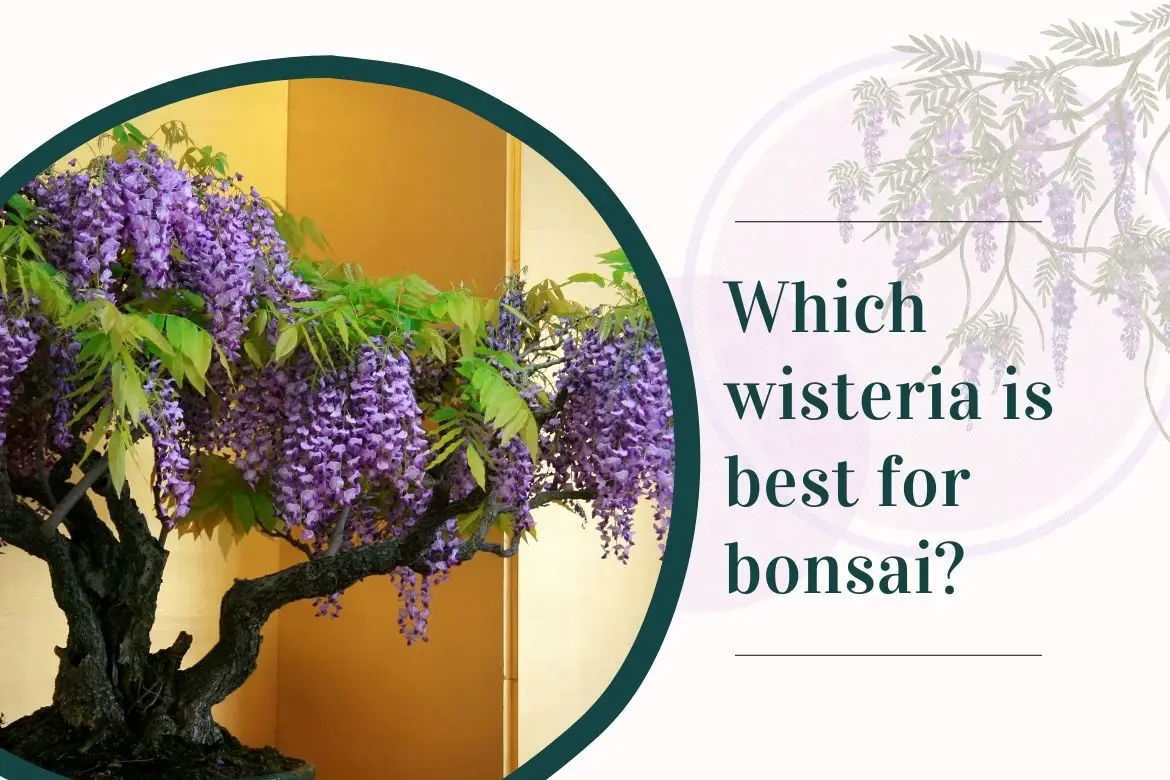There are several varieties of wisteria that are suitable for bonsai, but the two most commonly used are the Chinese wisteria (Wisteria sinensis) and Japanese wisteria (Wisteria floribunda). Both of these species are known for their beautiful, fragrant blooms and attractive foliage. Your preferred choice will depend on various factors, such as: growing zone, appearance, hardiness, growth habit and flower fragrance intensity.
Chinese wisteria (zone 5-9) is a hardy and vigorous plant that is well-suited for bonsai, with long, twisting branches that are perfect for shaping and training. It produces clusters of lavender or purple flowers in the spring, which can add a dramatic pop of color to a bonsai display. It is hardier than Japanese wisteria.
Japanese wisteria (zone 4-10) is also a popular choice for bonsai, with slightly smaller leaves and more delicate, drooping flowers in shades of blue, pink, or white. This species is known for its elegant, cascading growth habit, which can be enhanced through careful pruning and training. Flowers of Japanese wisteria have a stronger aroma.
In the end, the best wisteria for bonsai will depend on personal preference and the growing conditions in your area. Both Chinese and Japanese wisteria can make beautiful bonsai specimens when properly cared for and trained. For more details, please read Wisteria bonsai care.
Is wisteria easy to bonsai?
Wisteria can be a challenging plant to bonsai, especially for beginners. However, with some patience and skill, it is possible to create beautiful and impressive wisteria bonsai specimens.
Beginners may want to start with a more forgiving species before attempting wisteria bonsai, but with practice and experience, it is possible to create stunning wisteria bonsai specimens.
Few challenges a bonsai grower will face while growing a wisteria bonsai are:
- Rapid growth rate: One of the main challenges of wisteria bonsai is its rapid growth rate, which can make it difficult to maintain the desired shape and size of the tree. Regular pruning and training are essential to keep the plant under control and promote healthy growth.
- Test of patience: Wisteria is mainly grown as a bonsai for its flowers. However, this plant takes considerable time to reach maturity and bloom (sometimes 10-15 years).
- Special care needs: Improper watering (dry roots) can also lead to failure to bloom. Hence, the tree needs more care and maintenance.
- Weight of wisteria: Another challenge is the heavy weight of wisteria, especially when it is in full bloom. Bonsai enthusiasts need to ensure that their wisteria bonsai is properly supported and that the pot and soil can handle the weight of the plant.
Despite these challenges, wisteria bonsai can be highly rewarding for those who are up to the task. The plant’s twisting branches, cascading flowers, and attractive foliage can create a striking display when properly trained and cared for.
How big do wisteria Bonsai trees get?
Wisteria plant is mainly suitable to make medium to extra-large bonsai. A mature wisteria bonsai can grow to a height of 1 to 3 feet and a width of 1 to 3 feet.
The size of a wisteria bonsai tree can vary depending on the specific variety, the age of the tree, and the skill of the bonsai enthusiast in training and pruning the plant. It is important to note that wisteria is a fast-growing plant, and if left unpruned, it can quickly outgrow its pot and become too large for bonsai display.
To keep a wisteria bonsai tree small and compact, it is necessary to regularly prune and train the plant. This involves trimming back new growth, shaping the branches, and controlling the size of the tree through careful pruning techniques.
With proper care and attention, wisteria bonsai trees can be trained to take on a range of shapes and sizes, from elegant cascades to more compact and upright bonsai styles.
How do you keep wisteria bonsai?
When it comes to placing a wisteria bonsai, there are a few key factors to consider:
- Light: Wisteria bonsai trees prefer a bright location with plenty of indirect sunlight. Avoid placing the tree in direct sunlight, as this can cause leaf scorch and damage to the plant.
- Temperature: Wisteria bonsai trees prefer moderate temperatures and should be protected from extreme heat or cold. Keep the tree in a location with stable temperatures and avoid exposing it to drafts or temperature fluctuations. When keeping it in a greenhouse, a constant temperature of around 50°F (10°C) is needed. Also provide the tree shelter when the temperature falls below 23°F (-5°C).
- Humidity: Wisteria bonsai trees prefer a humid environment, so it can be helpful to place the tree in a location with high humidity. Keep the bonsai pot on top of a shallow tray with pebbles and water in summer to increase humidity around the bonsai. The pebbles will ensure that the bottom of the pot is raised above the water level on the tray.
- Display: Wisteria bonsai trees can be displayed on a table or stand, or placed on the ground in a decorative pot. Consider the size and style of the tree when choosing a display location and pot.
- Accessibility: Wisteria bonsai trees require regular care and attention, so it is important to place the tree in a location that is easily accessible for watering, pruning, and training.
Is wisteria bonsai poisonous?
Yes, wisteria is toxic to humans and pets if ingested in large quantities. The plant contains a chemical called lectin, which can cause nausea, vomiting, stomach pain, and diarrhea. In severe cases, it can also cause difficulty breathing, confusion, and even coma.
It is important to keep wisteria plants out of reach of children and pets, and to avoid consuming any part of the plant. If you suspect that someone has ingested wisteria, seek medical attention immediately.


